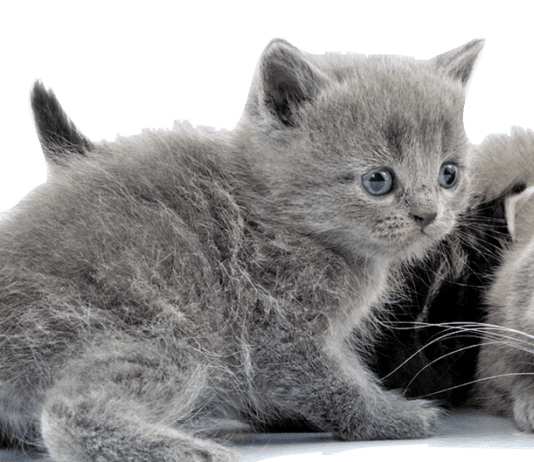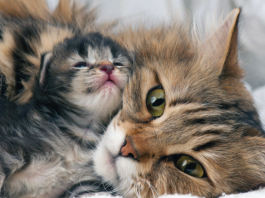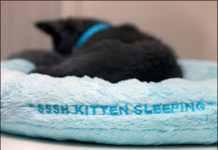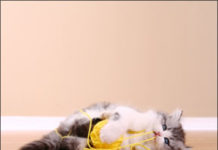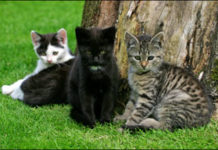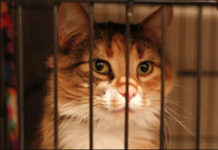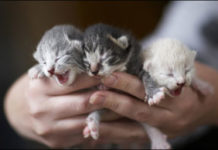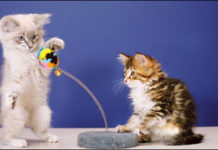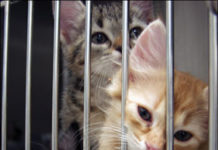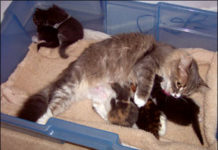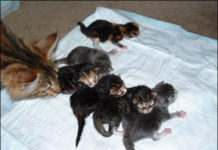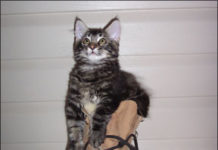Kitten Care: Starting Off Right
Are you considering adopting a new kitten? While the love part is a no-brainer, the responsibility can sometimes come as a surprise. In addition to choosing high-quality food, litter and toys, a new owner must take a proactive role in the kitten’s health. During your new pet’s first year, a veterinarian will examine the kitten a number of times in order to identify and treat or prevent any potential health or behavioral problems. There is not a set list of medications and vaccines that every kitten should receive, so owners need to consult with their veterinarian before deciding what is appropriate and what may not be. But keeping your kitten healthy isn’t just about vaccines and medicine. Here’s what else you need to consider.
Short Takes: April 2011
Researchers studied the effect of distance and neighborhood-level demographics on the number of pet adoptions from an animal shelter ("Use of geospatial neighborhood control locations for epidemiological analysis of community-level pet adoption patterns," American Journal of Veterinary Research, 2010). The methods used to perform the study included client segmentation, geospatial tools, and epidemiological techniques that evaluated locations of 1,563 adoptions from an animal shelter in eastern Massachusetts.
Ask Elizabeth: June 2010
Kudos to you for adopting a special needs little fella. Bob most likely was exposed to feline panleukopenia virus, sometimes called feline distemper or feline parvo virus, either shortly before or shortly after birth. This exposure caused a condition called cerebellar hypoplasia, or underdevelopment of the cerebellum. The cerebellum is located at the base of the brain, is responsible for coordination of movement and plays a role in balance. Kittens that are exposed to panleukopenia virus during development of the cerebellum (generally the last two weeks of gestation up until about four weeks of age) wind up with a cerebellum that is too small and doesnt function properly. Cerebellar hypoplasia can result from exposure to panleukopenia virus itself or from modified live panleukopenia vaccines given to cats during pregnancy or to kittens prior to four weeks of age.
Short Takes: April 2010
Ingestion of foreign bodies - including string-like objects - is a common problem seen in feline veterinary medicine. Foreign bodies may cause partial or complete gastrointestinal (GI) obstruction, which results in disturbances of fluid and electrolyte balance as well as dehydration. Damage to the intestinal tract can also occur. This study ("Gastrointestinal foreign bodies in dogs and cats: a retrospective study of 208 cases" in the Journal of Small Animal Practice, 2009) reviewed the records of 208 cases of GI foreign bodies in dogs and cats that were brought in to the RSPCA Greater Manchester Animal Hospital in the UK from June 2003 to May 2007.
Ask Elizabeth: January 2010
Dear Elizabeth, My cat, Abby, recently had a litter of kittens and the kittens are so different from each other in terms of size, color and personality, that I think they must have come from different fathers. One kitten is fine-boned, white with grey patches and long haired, while two of the others are short-haired, stocky and black. Abby showed up at my door, pregnant, so I have no idea if she actually mated with more than one male. Is it possible that the kittens have different dads? And what is an average size litter for a cat? Abby had three kittens, which I think of as average, but the cat down the road recently had nine kittens!
Microchips to the Rescue
A study published in the Journal of American Veterinary Medical Association ("Characterization of animals with microchips entering animal shelters," July 2009) determined that 7,704 microchipped animals entered 53 animal shelters between August 2007 and March 2008. Of this number, strays made up more than half (53 percent), with the remainder considered as owner-relinquished animals (41.9 percent) and other (5.1 percent). The results showed that animal shelters were able to find the owners of three-fourths of stray dogs and cats with microchips. The sucess in finding owners was higher in dogs, animals that were purebred and animals that were spayed or neutered. Animal shelters had a much higher likelihood of finding an owner when the owner information was in the shelters own database or registered with a microchip registry. The results emphasize the importance of the registration process in successfully reuniting pets and owners.
Ask Elizabeth: 11/09
I can think of no better way to add excitement and joy to an empty nest than by raising a litter of orphaned kittens. By fostering kittens for a shelter, you will ease the burden on shelter workers since caring for orphans can be time-consuming. You will also provide an environment free from many of the contagious diseases that are so problematic, and often fatal, to vulnerable youngsters in shelters. Raising orphans is labor intensive, but as you see your tiny, helpless balls of fluff transformed into playful, inquisitive youngsters, Im sure youll consider your time well-spent.
Entertain Your New Kitten!
Perhaps the most endearing characteristic about kittens is their propensity for play; every kitten seems to be hard-wired to appear especially cute and to play unabashedly. It isnt until youve been awakened at midnight with little kitty claws batting at your toes, however, that you begin to realize the very real need kittens have for play. Its not just something they do to fill the time; they will set their alarms two hours early to ensure that they have plenty of play practice time! And, just like any small child, if a kitten is not given plenty of appropriate ways to play, he will find even more inappropriate ways. Dr. Julia Albright, Resident in Animal Behavior at Cornell Universitys College of Veterinary Medicine, explains why play is essential for kittens. "It provides social interaction, exercise and appropriate expenditure of energy. Cats are very good at finding inappropriate means of expending exuberance (i.e. attacking your leg!) if not given object play. It also allows them to learn bite inhibition; orphaned kittens are often very aggressive and bite very hard as adults." Dr. Albright relates that, "Play involves components of adult behavior such as hunting (stalking, pouncing, biting, etc.) and is hypothesized to be practicing of these skills." So it is extremely important to provide appropriate outlets for a kittens seemingly endless desire to play if you want a well-adjusted addition to your family.
Foster a Kitten: And Save a Life
Consider this: One cat and her offspring can produce a whopping 420,000 cats in just seven years. Yikes, thats a lot of cats. Each year, from April to November, hundreds of thousands of kittens are born - often to feral or stray moms that eke out a meager existence on our city streets, in the suburbs and in rural areas across America. Without human intervention, most of these newborns will die or, at best, lead short, miserable lives. The moms that are not killed by cars, other animals or disease, will repeatedly become pregnant, adding to the already crushing pet overpopulation problem. Aside from ensuring that your own cats are spayed and neutered, consider fostering a litter of homeless kittens. Sadly, many animal shelters dont have the staff or resources available to care for kittens that are ill or too young for adoption. Newborn kittens that have lost their mom must be bottle-fed around the clock and their tiny bladders and bowels must be expressed on a regular basis. Animal shelters that have kitten foster programs in place need dedicated people who are willing to welcome kittens into their home and nurture them until they are old enough to be placed for adoption.
Help Your Kitten Develop Healthy Eating Habits
For cat lovers, few things are more pleasurable to witness than the astounding progress that a kitten makes in terms of physical development during the first year of its life. Typically weighing about three and a half ounces at birth, a kitten - if properly fed - will gain as much as a half-ounce per day; its birthweight will double in the first week; and it will have tripled its birthweight by the time it is three weeks old. As the weeks pass, the little creatures rate of growth rate will gradually slow, but it will reach its adult size by the it is 10 or 12 months old. Passage through the first year - transitioning from total dependency on its mothers milk to the cutting of its baby teeth and its introduction to an adult diet - can present a formidable challenge to a young cat. Throughout this period, during which the kitten's weight increases 50-fold, it can use all the loving care and attention it can get from its owner, especially in meeting its nutritional needs.
Mothering Myths & Truths
The ancient Egyptians revered her in the form of Bastet, the feline goddess of fertility and protector of women and children. Other ancient peoples kept small statuettes of her with suckling kittens throughout their homes to bring good luck. Modern science has studied her, attempting to explain her ways. Who is she?
Best Care For a New Kitten
It is well known that few can resist the winsome charm of the teeny, tiny kitten. He is loving, playful, downright adorable and a wonderful companion. I remember, as a child, bringing home two beautiful kittens.

